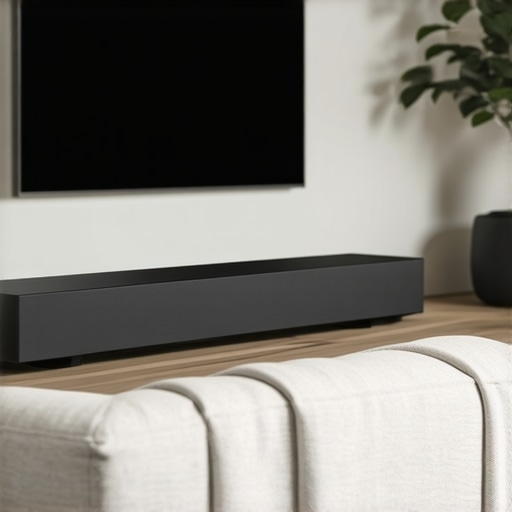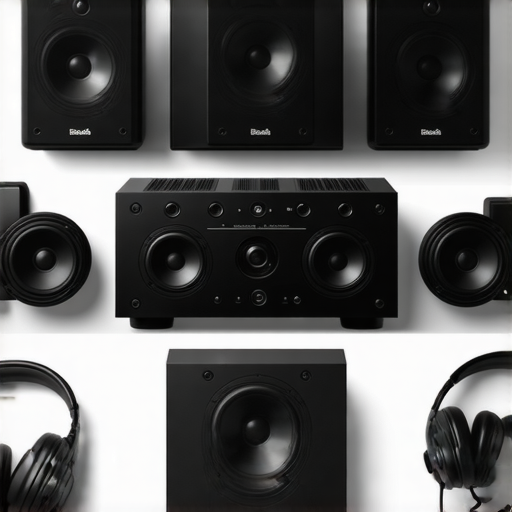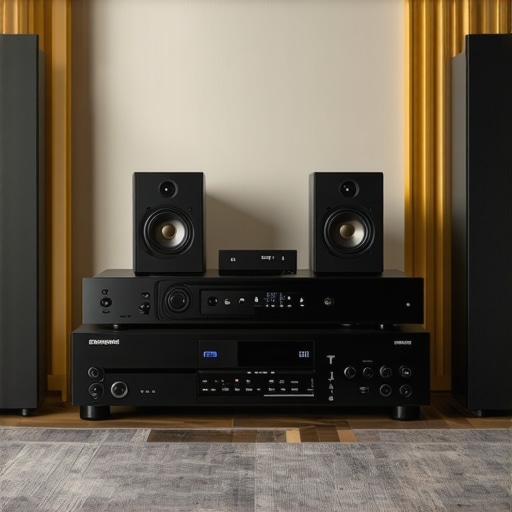My Journey into the World of Home Audio: Finding the Best Deals
Last month, I decided it was time to upgrade my home audio system. With so many options out there, I felt overwhelmed but also excited to discover some of the top home audio deals on speakers and amplifiers available this month. As someone who loves immersing myself in music and movies, I wanted gear that delivers quality without breaking the bank.
Why I Focused on Speakers & Amplifiers for My Home Setup
After reading reviews and browsing deals, I realized that speakers and amplifiers are the heart of any home audio system. They determine the clarity, power, and overall experience. I wanted to find equipment that balances affordability with high performance. Interestingly, according to What Hi-Fi?, choosing the right speakers can transform your listening experience, making it worth the investment.
My Top Picks for This Month’s Best Deals
While exploring, I came across some fantastic discounts. For example, the latest deals on premium soundbars and surround sound speakers are quite tempting. The soundbar deals for 2024 caught my eye—perfect for upgrading my living room. I also found excellent discounts on classic stereo amplifiers that deliver warm, rich sound.
How to Spot the Best Audio Deals and Save Big
In my experience, timing and research are everything. I always compare prices across multiple stores and look for seasonal sales or special promotions. Additionally, reading customer reviews helps gauge reliability and sound quality. This approach not only saved me money but also ensured I got gear that truly enhances my listening experience.
What About Future-Proofing My Home Audio System?
That’s a question I often ask myself. Technology evolves rapidly, so I want gear that can adapt to future upgrades. For instance, investing in a good amplifier with Bluetooth and Wi-Fi connectivity lets me stream music seamlessly from my devices. For more insights on selecting versatile equipment, I recommend checking out trusted sources like CNET’s home theater reviews.
Am I really getting the best value, or just chasing deals?
This is a common question, and honestly, I think it depends on your priorities. Sometimes, paying a little more upfront for reliable, well-reviewed gear pays off in the long run. Other times, snagging a great deal on last season’s model can be a smart move. Ultimately, I believe balancing quality with price is key—I always ask myself if the deal offers real value for my needs.
If you’re like me, passionate about sound quality and smart shopping, I invite you to share your experiences or ask questions in the comments below. Exploring these deals has been a rewarding journey, and I hope my insights help you find the perfect home audio setup.
What Are the Hidden Factors in Choosing the Perfect Soundbar?
When it comes to upgrading your home theater, a soundbar can dramatically improve your audio experience. But beyond the flashy features and discounts, what should you really focus on? As an audio enthusiast, I’ve learned that understanding the nuances—like driver configuration, sound modes, and connectivity options—can make all the difference. For instance, a soundbar with Dolby Atmos support offers immersive multidimensional sound, elevating your movie nights. While browsing deals, I always check if the model supports HDMI ARC or eARC, which simplifies connectivity and enhances audio quality. Trusted sources like CNET emphasize that a well-chosen soundbar aligns with your room size and acoustic needs, rather than just the price tag.
How Can You Assess Sound Quality Before Making a Purchase?
Sound quality is subjective but crucial. From my experience, listening tests—either in-store or through detailed reviews—are invaluable. Pay attention to clarity, bass depth, and whether dialogue is crisp. Many online reviews include audio samples or detailed descriptions that help gauge performance. Additionally, consider your room’s acoustics; a compact space may benefit from a soundbar with a built-in subwoofer, whereas larger rooms might require a separate subwoofer for full-bodied sound. For those seeking expert insights, I recommend exploring resources like TechRadar, which provides comprehensive comparisons and real-world testing results.

What Innovative Features Are Worth Investing in for Future-Proofing?
Future-proofing your home audio system is about more than just current needs. I look for features that will remain relevant as technology evolves. For example, Wi-Fi streaming capabilities enable seamless integration with smart home ecosystems and multi-room setups. Voice control compatibility with assistants like Alexa or Google Assistant adds convenience and hands-free operation. As a bonus, many modern soundbars support Bluetooth, allowing quick pairing with your devices. Considering these aspects ensures your investment stays valuable over time. For a detailed guide on selecting adaptable audio gear, check out CNET’s reviews, which cover the latest innovations and compatibility tips.
Am I really getting the best value, or just chasing deals?
This is a question I often ask myself. While hunting for discounts is rewarding, I’ve found that quality and longevity often outweigh initial savings. Sometimes, investing a bit more in a reputable brand guarantees better durability and sound performance, saving money in the long run. Conversely, last season’s models on sale can sometimes offer nearly identical features at a fraction of the price. The key is to balance affordability with reliability. When I evaluate deals, I consider user reviews, warranty terms, and whether the features meet my needs. Remember, a smart purchase combines excellent value with future usability. If you’re eager to explore more about smart shopping tactics, I recommend reading detailed guides on reputable tech sites.
If you’re passionate about optimizing your home audio experience, I invite you to share your insights or ask questions below. Exploring these offers and features has helped me craft an immersive sound environment, and I hope my tips assist you on your journey.
How Do I Balance Sound Quality with Technological Innovation in My Home Setup?
As I continued my journey into creating an immersive home audio environment, I realized that the delicate balance between top-tier sound quality and cutting-edge technology isn’t always straightforward. For instance, investing in a high-end soundbar with Dolby Atmos support undoubtedly elevates your listening experience, but it also raises questions about compatibility with other smart devices and future upgrades. I found that aligning my gear’s connectivity options—like HDMI eARC, Bluetooth, and Wi-Fi—ensures seamless integration with my existing smart home ecosystem. According to CNET’s reviews, selecting equipment that prioritizes compatibility and firmware update support can make your system resilient against obsolescence. Personally, I prefer to focus on brands known for regular updates, which gives me peace of mind that my investment remains relevant for years to come.
Are There Hidden Trade-Offs in Choosing Connectivity Features for Future-Proofing?
While Wi-Fi streaming and voice control seem like must-have features, I’ve learned that they sometimes come with trade-offs. For example, adding voice assistants like Alexa or Google Assistant expands convenience but can introduce privacy considerations or compatibility quirks. Moreover, some features may inflate the cost without providing tangible benefits for your specific needs. I recall testing a premium soundbar with integrated smart features; while the voice control was impressive, I sometimes found the setup process cumbersome, especially when trying to troubleshoot connectivity issues. It made me appreciate the importance of prioritizing essential features aligned with my usage patterns. For detailed insights, CNET emphasizes evaluating whether these features genuinely enhance your experience or if they’re just marketing gloss. Sometimes, simplicity and reliability trump flashy extras when it comes to long-term satisfaction.
What Are the Practical Steps to Ensure My Investment in Home Audio Remains Valuable?
From my own experience, future-proofing is as much about strategic planning as it is about selecting the right gear. I always consider the upgrade path—whether my current setup can easily accommodate additional components like subwoofers or wireless speakers. For instance, choosing a receiver with multiple HDMI inputs and robust Bluetooth support allows me to expand my system without major replacements. Additionally, regular firmware updates from manufacturers can extend the lifespan of my devices, so I keep an eye on brands that prioritize ongoing support. I also make it a habit to follow expert reviews and community forums to stay informed about emerging standards, such as wireless audio protocols that could become industry norms. If you want to explore this topic further, this resource offers excellent advice on selecting adaptable audio gear that grows with your needs.
Ultimately, investing in home audio is a blend of understanding current tech, anticipating future trends, and making mindful choices that emphasize quality and compatibility. I’d love to hear your experiences or questions—share your thoughts below, and let’s navigate this evolving landscape together!
Bridging the Gap Between Acoustic Excellence and Technological Innovation
As I delved deeper into refining my home audio setup, I realized that achieving a perfect harmony between unmatched sound quality and embracing evolving technology requires a nuanced approach. It’s not just about purchasing the latest flagship model but understanding how to future-proof your system against rapid technological shifts.
One of the key considerations is selecting systems with modular components that facilitate upgrades. For example, opting for a receiver with multiple HDMI inputs, support for the latest HDCP standards, and robust wireless capabilities ensures that your setup remains adaptable. A prime example of this is the integration of **multi-room audio protocols** such as Apple AirPlay 2 or Google Cast, which allow seamless multi-device streaming and synchronization across different platforms. As emphasized on CNET, compatibility and support for firmware updates are crucial for longevity.
How Can I Ensure My Investment in Home Audio Keeps Pace with Future Innovations?
My approach centers on choosing equipment that adheres to open standards and industry certifications. This not only guarantees a degree of future compatibility but also mitigates vendor lock-in. For instance, selecting a soundbar or receiver that supports the latest HDMI 2.1 standards or DTS:X ensures compatibility with future 8K content and immersive audio formats. Moreover, prioritizing brands with proven track records of regular firmware updates, like Denon or Yamaha, offers peace of mind that your hardware won’t become obsolete prematurely.

Beyond hardware, I keep a keen eye on emerging trends such as Wi-Fi 6E and Bluetooth 5.2, which promise higher data transfer rates and lower latency. These advancements can significantly enhance streaming stability and audio fidelity. Additionally, integrating smart home assistants with your system can streamline control and automation, but it’s essential to weigh the privacy implications and ensure compatibility. According to TechRadar, choosing devices with open APIs and community support can extend their lifespan and customization options.
Are Hidden Trade-Offs in Connectivity Features Worth the Investment?
While features like voice control and multi-room streaming are alluring, I’ve learned that they sometimes introduce complexity or compromise on reliability. For instance, a smart speaker integrated into your audio system might occasionally experience lag or connectivity issues, detracting from the seamless experience you desire. It’s vital to evaluate whether these features genuinely enhance your daily use or merely add superficial value. I’ve found that prioritizing simplicity and stability often yields a more satisfying long-term experience, especially when paired with a solid core audio setup.
For comprehensive insights on navigating these trade-offs, I suggest exploring detailed reviews and community forums. Ultimately, a balanced approach—embracing essential features while maintaining system stability—ensures your investment remains resilient against obsolescence and evolving needs.
Engage with My Personal Journey into Advanced Home Audio Optimization
If you’re eager to deepen your understanding of future-proofing your home audio or share your own experiences, I invite you to connect. Navigating the labyrinth of technological advancements and high-fidelity sound is a rewarding endeavor when approached with strategy and knowledge. Let’s continue this conversation—your insights and questions are invaluable as we strive for the perfect auditory sanctuary.
Things I Wish I Knew Earlier (or You Might Find Surprising)
1. The Power of Room Acoustics
One revelation I had was how much my room’s acoustics influence sound quality. Initially, I focused solely on buying high-end gear, but I soon realized that furniture placement, curtains, and even wall materials significantly impact audio performance. I wish I’d understood earlier that optimizing my space can sometimes be more effective than upgrading equipment.
2. The Hidden Costs of Connectivity
Connecting multiple devices might seem straightforward, but hidden costs like needing extra cables, adapters, or even signal boosters can add up. A lesson I learned is to verify compatibility and connectivity options beforehand, saving both time and money in the long run.
3. The Value of Firmware Updates
Many overlook the importance of firmware updates, assuming their gear is set for life. I found that regular updates improve functionality, fix bugs, and sometimes even add new features. Staying current with manufacturer updates has extended my system’s lifespan and performance.
4. The Balance Between Features and Simplicity
While cutting-edge features like voice control and multi-room streaming are tempting, I realized that simplicity often leads to a more satisfying experience. Overloading a system with too many options can complicate setup and troubleshooting, so I now prioritize reliability over bells and whistles.
5. The Importance of Listening Tests
Reading reviews is helpful, but nothing replaces listening to gear firsthand. I discovered that my perception of sound quality varies based on source material and room conditions. Whenever possible, I test equipment in a setting similar to my own home before buying.
6. The Role of Aesthetics and Placement
Sound matters, but visual harmony is also important. I found that discreet, well-placed speakers integrate better into my decor and improve the listening experience by reducing sound reflections caused by clutter or poor placement.
Resources I’ve Come to Trust Over Time
1. CNET
CNET has consistently provided comprehensive, well-researched reviews on home audio equipment. Their detailed comparisons and update articles have helped me make informed decisions, and I recommend it to anyone serious about quality and technology.
2. What Hi-Fi?
This UK-based magazine offers expert insights on audio gear, emphasizing sound quality and value. Their reviews helped me understand the nuances of different speakers and amplifiers, guiding me toward reliable choices.
3. TechRadar
For the latest in smart home integration and gadgets, TechRadar is my go-to source. Their coverage on compatibility and future-proofing has been invaluable in planning my setup.
4. Forums and Community Boards
Online forums like AVS Forum and Reddit’s r/hometheater provide real-world experiences and troubleshooting tips. Engaging with these communities has broadened my perspective beyond commercial reviews.
Parting Thoughts from My Perspective
Embarking on the journey of home audio optimization has taught me that understanding the nuances—like room acoustics, connectivity options, and the importance of ongoing updates—is crucial for creating an immersive sound environment. It’s not just about buying the most expensive gear, but about making smart, informed choices that balance quality, functionality, and future-proofing. If this resonates with you, I’d love to hear your experiences or questions. Sharing knowledge helps us all build better audio setups and enjoy richer soundscapes at home.

